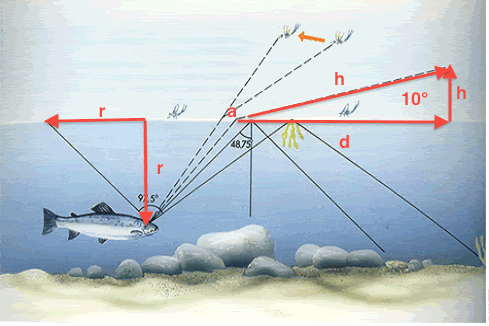
"This also brings up a very important point when casting to a fish that is feeding on or close to the surface of the water. Many anglers cast too far in front of the feeding fish and that allows all kinds of problems to develop by the time their fly reaches the fish. ??.. When I'm fishing to fish visibly feeding on or near the surface I rarely place my fly more than a foot above the feeding fish and often I drop it even closer. This requires that you can cast accurately and delicately but the results are that your imitation doesn't have time to drag before it reaches your intended target. Works for me and it will work for you."
As you said, you can cast just above the fish only when the fish is close to the surface. Allow me to be more precise in how far above the fish you should cast.
The depth of the fish changes the size of the window. In the diagram below I have added arrows for the size of the window and the depth of the fish. You will also notice that the angle of the window from the trout's eye is 97.5?. Half of that if 48.75? which is about 45?. At 45?, the distance = r from the center of the window to the edge of the window is exactly equal to the depth =r of the fish. So we can approximate the the size of the window from the depth of the fish. The window diameter is 2r or about twice the depth of the fish.
This means the front edge of the window is equal to the depth R of the fish.

So cast no closer to the fish than the depth it is holding during feeding. I should note that objects in the water look more shallow than they are. Depth is distorted. So if a fish looks a foot deep, it is deeper and the window is wider. So cast further above the fish to compensate for this distortion.
Regards,
Silver
"Discovery consists of seeing what everybody has seen and thinking what nobody has thought"..........Szent-Gyorgy





 Reply With Quote
Reply With Quote
